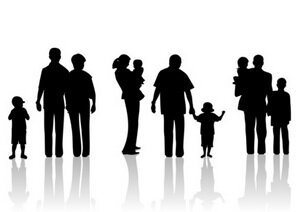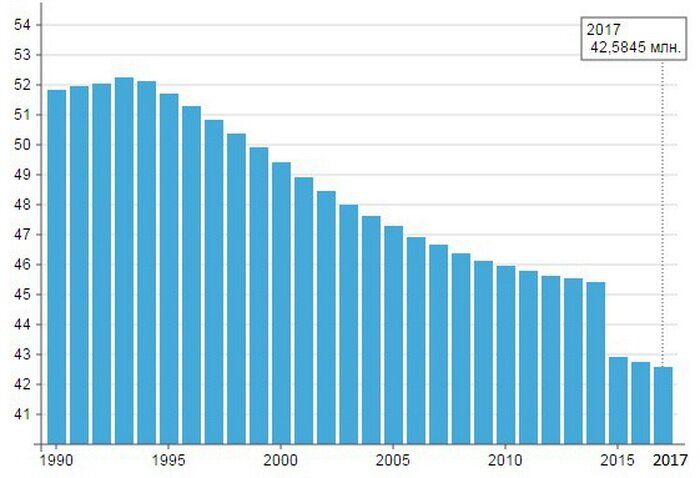
Myroslav Dnistryanskyi
Doctor of Geographical Sciences, Professor
The sharp demographic crisis in Ukraine causes confusion in different groups of the Ukrainian society. People simply cannot understand why the population of the state has so drastically decreased: while in 1992 we had 52.06 million people, then in 2013 — 45.55, in 2017 — only 42.5 million people (without the occupied territories of the Crimea and Donbas). By the number of the population Ukraine has fallen from the 22nd place in the early 90's of the 20th century to the current 32nd place in the world (in 2015). Mainly due to the sharp overbalance of the number of deaths over the number of births, in the last decade our state has been annually losing from more than 400 thousand people (in 2000) to 80 thousand people (in 2013). Huge by volumes is the labor and educational migration (several million people). At this, a significant part of such migrants have already made a decision on non-return to Ukraine. It is clear that such demographic losses, substantially weakening the aggregate potential of the Ukrainian society, including personnel and military mobilization, give raise to concern about the fate of the country. Therefore, people want to understand why this has happened and if the situation can be changed for the better.
Given the special relevance, scientists, politicians and socio-political figures of different backgrounds are trying to find the answers to these questions. And here, unfortunately, along with attempts to objectively analyze demographic phenomena, there is often a superficial vision of the essence of the demographic crisis, and sometimes purposeful fake posturing. In particular, some political forces in Ukraine, especially those that genetically originate from the Russian Bolshevism, incorrectly link these negative trends with geopolitical changes (the collapse of the USSR, formation of an independent Ukraine). At the journalistic level, the decline in natural growth, which in the 1990s – at the beginning of the 21st century was the main negative factor in the demographic development, is unilaterally and superficially connected only with the decline of the welfare of the population. And from here — mutual political accusations of leading and opposition political forces. Although in reality, as is well known, the highest natural growth rates are characteristic of the underdeveloped states. And precisely they have provided the noticeable demographic explosion in the world in recent decades. Alarming are also some proposals for solving demographic and labor-resource related problems that may have even more negative geopolitical and geo-cultural consequences for Ukraine. These include, first of all, speculative recommendations for the promotion of immigration to Ukraine of people from Asia or even North Africa, which from time to time are voiced by individual interested circles*.

|
| Population of Ukraine 1990–2017, in millions. Source: Ukrstat |
So, taking into account both, the negative processes of the demographic development and the presence of geopolitical speculations over the demographic crisis, there is a need for objective analytical comprehension of this problem and adequate informational coverage.
To understand the reasons for the demographic crisis, we will make a brief retrospective analysis of the annual indicators of natural growth of the rural and urban population of Ukraine, beginning from the middle of the 20th century. And it turns out that most of the prerequisites for the depopulation (natural reduction) of the population of Ukraine developed in the 70–80s of the last century, when in fact a complex demographic transition began. What was it all about? In short, the demographic transition is an objective process of giving up the traditions of a large family in the process of industrialization and urbanization and turning to a simple, and subsequently narrowed reproduction [i.e. one family — two children (simple reproduction); one family — one child (narrow reproduction)]. In Western Europe, the demographic transition began in the first half of the 20th century and ended in the post-war period. In Ukraine, the trends of the demographic transition combined with different socio-economic processes and miscalculations of the social policy of the then USSR. Symptomatic in this aspect is the fact that the coefficient of natural growth in the rural Ukraine became negative back in 1979, when the number of the deceased exceeded the number of births. Such tendencies were mostly observed in those regions where, due to ill-conceived socio-economic policies, the young rural population was “absorbed” by such large agglomerations as Kyiv and Kharkiv (Chernihiv, Sumy, Poltava) regions, laying the preconditions for landslide aging of the rural population and, accordingly, a sharp decline in fertility, which became the main factor in the demographic crisis in those regions. In particular, in 1980, with the average in Ukraine coefficient of natural increase of the rural population of -0.7 ‰, — in Chernihiv region it dropped to -7.6 ‰, in Sumy region — to -7.5 ‰, and in Poltava region — to -7.3 ‰. That is, the propaganda of the ideas of the concentration of production in large centers, artificial stimulation of urbanization, considering the majority of rural settlements unpromising, lack of means of production in them had caused in some regions large disproportions in the age structure of residents of large cities and rural areas. The demographic losses of the 1930s – 1940s of the last century as a result of the Holodomor and political repressions, as well as the mass moving of youth to the so-called five-year plans new developments. At the same time, many rural people who came to large cities and encountered domestic and other social problems, gradually, taking into account new cultural and mental priorities, moved to the model “one family — one child”. That is, the traditions of a larger family, or, in other words, simple or extended reproduction, could survive neither in rural areas (due to lack of human resources), nor in large cities (due to socio-economic problems and the trends of demographic transition). Thus, depopulation processes in the countryside of many regions of Ukraine began long before the territorial-political changes of the 1990s of the last century and were determined, above all, by factors such as accelerated (sometimes artificial) urbanization combined with the aging of the rural population.
The increase in unfavorable demographic trends in the late 70s of the 20th century led to the fact that already in 1980 the natural growth rate of not only the rural population, but also of the total rural and urban population of the five regions (Vinnytsia, Poltava, Sumy, Cherkasy, Chernihiv) became negative. In 1985 Kirovohradska joint those regions, and the natural increase of virtually all regions was inexorably falling. In 1990, natural growth was negative in almost half of the regions, and its total value was only 0.6 ‰. Such negative trends logically resulted in the transition to the natural reduction of the population, which was observed already in the following year, 1991 (the coefficient of natural growth was -0.8 ‰), and remains to this day. The fact that the transition of the population of Ukraine as a whole (apart from individual regions) to a natural reduction took place in the same year as the proclamation of independence by Ukraine is nothing else but a coincidence of completely different processes. At the same time, in the western regions, taking into account the more optimal age structure of the population, especially of the rural one, the coefficient of natural growth for a long time remained positive. In particular, during the 1990s and to date, the positive value of the coefficient of natural growth has been preserved in Trans-Carpathian and Rivne regions. However, already at the turn of the 20th and 21st centuries, the demographic transition to depopulation of rural areas began in the western regions too. So, since 1994, as a result of natural reduction, as well as negative migration growth, the population of Ukraine has been decreasing all the time.
 Negative tendencies of population reproduction were observed in the 80s of the last century and deepened as a result of the acute economic crisis of the 1990s. But the economic downturn should not be considered directly as the main factor in the demographic crisis. We are talking only about certain laying of economic problems on social, and, consequently, demographic ones, exacerbating the already existing negative processes. In particular, this concerns the reduction of the number of marriages and the sharp increase in the number of divorces: since 1993, on average, there was 1 divorce per 2 registered marriages. That is, the acute manifestations of the demographic crisis are due to the cumulative effect of a number of actual internal-demographic processes, in particular the deepening of disproportions in the gender-age and socio-age structure of the population, which in general had a negative effect on all mechanisms of reproduction of the population. Indirectly these processes are influenced by various social factors. In particular, the high level of religiousness of the population of the western regions predetermines a significantly smaller number of divorces, and indirectly (due to a significantly smaller number of abortions) contributes to the growth of fertility. At the same time, economic problems have significantly affected the second, after a natural reduction, a part of a general decrease in the population of Ukraine — the formation of a negative balance of external migration, which has become characteristic of Ukraine for a decade (1994–2004). As a result of the migration reduction, according to official data, the population of Ukraine decreased by 1,221 million people, which is about 20 % of the total decrease in the population in Ukraine. The largest indicators of migration decrease are in the second half of the 90-s of the last century. But since 2005, the balance of external migration, according to statistics, has become positive. Although de facto the situation is actually more complicated, as a significant part of foreign workers who are not yet formally emigrants are no longer intending to return to Ukraine.
Negative tendencies of population reproduction were observed in the 80s of the last century and deepened as a result of the acute economic crisis of the 1990s. But the economic downturn should not be considered directly as the main factor in the demographic crisis. We are talking only about certain laying of economic problems on social, and, consequently, demographic ones, exacerbating the already existing negative processes. In particular, this concerns the reduction of the number of marriages and the sharp increase in the number of divorces: since 1993, on average, there was 1 divorce per 2 registered marriages. That is, the acute manifestations of the demographic crisis are due to the cumulative effect of a number of actual internal-demographic processes, in particular the deepening of disproportions in the gender-age and socio-age structure of the population, which in general had a negative effect on all mechanisms of reproduction of the population. Indirectly these processes are influenced by various social factors. In particular, the high level of religiousness of the population of the western regions predetermines a significantly smaller number of divorces, and indirectly (due to a significantly smaller number of abortions) contributes to the growth of fertility. At the same time, economic problems have significantly affected the second, after a natural reduction, a part of a general decrease in the population of Ukraine — the formation of a negative balance of external migration, which has become characteristic of Ukraine for a decade (1994–2004). As a result of the migration reduction, according to official data, the population of Ukraine decreased by 1,221 million people, which is about 20 % of the total decrease in the population in Ukraine. The largest indicators of migration decrease are in the second half of the 90-s of the last century. But since 2005, the balance of external migration, according to statistics, has become positive. Although de facto the situation is actually more complicated, as a significant part of foreign workers who are not yet formally emigrants are no longer intending to return to Ukraine.
The above-mentioned general trends in Ukraine's demographic development over the last thirty years have determined the characteristics of the current demographic situation, although some new alarming phenomena have emerged in recent years. Thus, according to official data, today in the state as a whole there is a negative natural increase, which in 2016 amounted to -4.4 ‰. Since 2006, there has been a general positive tendency to growing of this important demographic indicator, which is due to the intensification of the demographic policy of the state, first of all with the increase in financial assistance at the birth of a child, but since 2012, the natural decline in population has again begun to grow. The same is true of most other unfavorable factors of demographic development, and some negative trends are only getting aggravated. This, in particular, concerns the further deterioration of the situation in the most problematic regions (Chernihiv, Sumy and Poltava), gradual aging of the population and a decrease in the proportion of able-bodied people. There is also a very high level of inequality of the sexual structure of the population (53.7% — women, 46.3% — men), the number of divorces is critically growing (averagely, 3.3 divorces per 5.9 marriages), high mortality remains, especially in rural areas. That is, there are many signs of a demographic threat of an all-nation scale.
 In this situation, there is a clear need to revitalize the state's demographic and socio-economic policy. But what can be really done? It is practically impossible to substantially change the trends of the demographic transition, that is, to return to the traditions of a large family. Or to quickly optimize the gender-age structure of the population. But, one way or another, giving up the model “one family — one child” and the transition on average in the country to simple reproduction (one family — two children) is in line with modern Ukrainian socio-mental orientations and, in principle, is possible if the state provides relatively small social guarantees. What other demographic indicators can be indirectly influenced by the state? First of all, the reduction of the number of divorces, through developing programs for supporting young families, especially housing, work in specialty, etc. Such programs do settle a number of similar demographic problems in highly developed states of Europe. It is also necessary and really feasible to reduce children's and unnatural mortality (on roads, as a result of accidents in mines, etc.).
In this situation, there is a clear need to revitalize the state's demographic and socio-economic policy. But what can be really done? It is practically impossible to substantially change the trends of the demographic transition, that is, to return to the traditions of a large family. Or to quickly optimize the gender-age structure of the population. But, one way or another, giving up the model “one family — one child” and the transition on average in the country to simple reproduction (one family — two children) is in line with modern Ukrainian socio-mental orientations and, in principle, is possible if the state provides relatively small social guarantees. What other demographic indicators can be indirectly influenced by the state? First of all, the reduction of the number of divorces, through developing programs for supporting young families, especially housing, work in specialty, etc. Such programs do settle a number of similar demographic problems in highly developed states of Europe. It is also necessary and really feasible to reduce children's and unnatural mortality (on roads, as a result of accidents in mines, etc.).
But, one way or another, the main social and demographic problem is the labor migration, which can be solved only by ensuring a substantial economic recovery and, consequently, creating new jobs. At this, it must be realized that this is really possible only on the basis of new industrialization, in the rejection of the illusion of a possible leading role in the services sector, in particular, tourism. That is, such industries also need to be developed, but we should bear in mind that they can provide jobs for less than one percent of the able-bodied population. It is important to note that economic growth and job creation are able to significantly limit the migration of young people for higher education in neighboring states, which is now being actively pushed through various shadow ways. Unfortunately, so far the Ukrainian government has not been taking any steps to intensify industrial production in our country, nor has it shown understanding of the need for such action. Also, in the strategic context, the need for a comprehensive socio-economic and cultural development in the countryside of Ukraine is very sharp, for which there are both domestic (above all significant agro-climatic resources) and external prerequisites (the growth of world food needs). But at the same time, the state maintains extremely unfavorable conditions for economic activity, in particular, for the development of a farm. Instead of supporting farms, the development of which could provide the economic basis for improving the demographic situation in the rural areas, the government is now planning to abolish the moratorium on the sale of agricultural land, which could lead to the complete destruction of the Ukrainian village and trigger a new wave of emigration. So, since there are no grounds for talking about the government's real constructive actions to improve the demographic situation, therefore the threat of growth in demographic losses remains real.
--------------------------------------------------
* Ukraine will become a desert inhabited by Africans and Asians — sociologists [Electronic resource]. — Mode of access: http://life.pravda.com.ua/society/2011/01/27/71009

